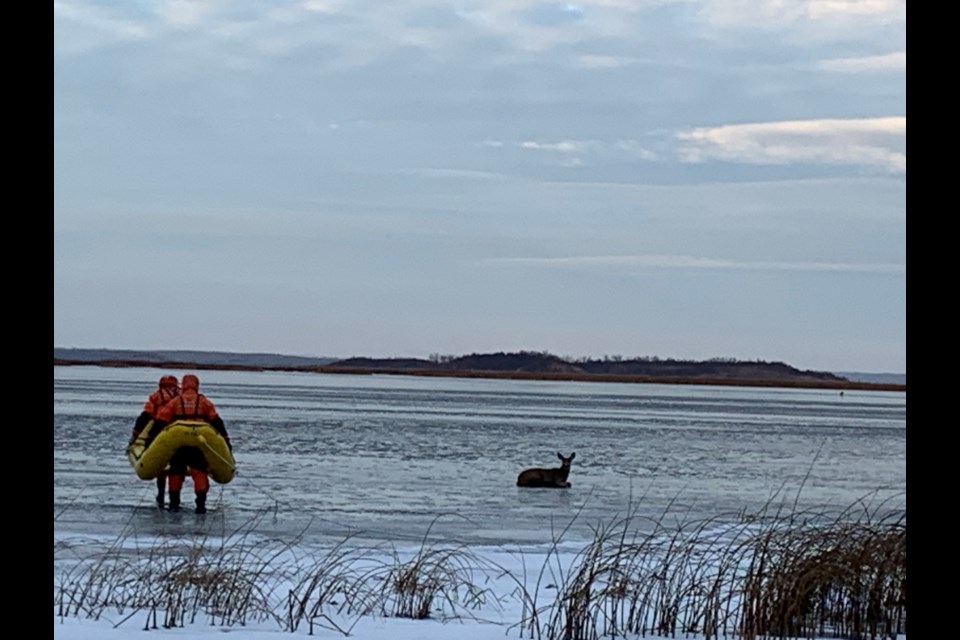LAC LA BICHE - The onset of the winter months means that lakes in the Lakeland region are freezing over.
In a community surround by water bodies where many enjoy year-round recreation, Lac La Biche County Fire Rescue Service officials are once again promoting ice safety to local residents.
Those same officials have already been called out for an ice rescue, despite temperatures only recently dropping below the freezing mark.
On Nov. 1, crews were wading into the chilly lake waters to rescue a deer that had fallen through a thin layer of ice on Lac La Biche lake. The deer was in distress, say Lac La Biche County’s Manager of Protective Services John Kokotilo, causing a passing resident to call the fire department
Trained in ice rescue, a crew went to the scene. Equipped with specialized cold-water gear and an ice-rescue boat, Kokotilo said the firefighters calmed the animal and carefully pulled it from the icy water.
It was a unique rescue, said Kokotilo, who is also the regional fire chief, but the result was what they hope for each call they go to. The deer was safely transported to the shore where it quickly recovered and ran away.
Awareness
Kokotilo says members of Lac La Biche County’s Fire Rescue Service typically respond to several calls during the winter months involving what he describes as “thin or open ice incidents”. Most incidents involve either quad or snowmobile travelling on thin ice, or pets falling through thin ice and owners finding themselves in danger as they attempt to rescue them.
“We have several personnel trained in ice rescue,” he said, adding that the fire rescue service has various pieces of equipment at its disposal, including dry suits, flotation devices, ropes, and the inflatable “banana boats” that slide across the ice.
Although lake ice will eventually grow to more than three feet in thickness on some local water bodies over the cold winter months, temperatures currently haven’t dropped steadily enough.
Kokotilo said during temperature fluctuations, people must always keep in mind that ice is still forming and is not safe to be on.
“Make sure kids are always under supervision and keep pets on a leash,” he said. “Do not attempt to go out on ice or rescue people or pets. Call 9-1-1 and maintain visual contact.”
County fire officials are also advising residents to beware of ice near the inlets and outlets of streams and to avoid ice near open water. Kokotilo continued by saying that it is crucial for people to always take extra precautions on river and stream ice.
“Ice can vary in thickness and strength from area to area because of temperature, water current, springs, snow cover, and time of year,” he said.
When the temperatures do allow for safe access on to frozen water, Kokotilo says common sense, awareness and some general tips help to keep safety at the forefront.
“Keep an eye on ice and snow conditions ahead of you,” he said. “If the weather has been warm or heavy snow has depressed the ice, there may be hidden slush that can trap a vehicle.”
Tow ropes and shovels are items that should be packed inside any private vehicle heading across an ice-covered water body.
When travelling across ice, motorists must be mindful not to drive fast, or follow closely behind another vehicle, Kokotilo says. He also advises people not to park next to other vehicles or heavy equipment on the ice. The of people, vehicles, or heavy snow can cause ice to bend and crack.
Telling people your travel plans, carrying winter survival items like blankets and candles, and keeping a charged phone within reach are also good tips.
If you go through
If a vehicle does go through the ice, occupants should get out as soon as they realize what is happening. If people fall into the water, Kokotilo said they need to quickly get to the edge of the ice and try to break their way to ice that can hold their weight, then crawl up.
Retail stores do sell hand grips that can be attached to jackets or tied around wrists.
“Crawl on your belly up on ice, spreading your weight out as much as possible,” he said, adding that the hand grips are useful for additional traction in such a crisis.
Once a person gets out of the icy water, getting them re-heated is a priority.
“Immediately seek a warm place to remove wet clothes. This may mean going to shore and quickly building a fire. Remember…hypothermia can set in quickly and leave you helpless.”
With so much water, and so much risk, Kokotilo says common sense is always the best determination when it comes to avoiding trouble.
The general rule, he says, is “when in doubt, don’t do it.



